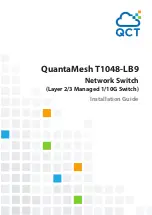
2 – Theory of Operation
T1 CrossConnect Installation & Operation Manual
Version 2
GatesAir
2-15
Intraplex Products
required traffic pattern, use a unidirectional ring. Keep these guidelines in mind when selecting a ring
configuration:
●
You probably need a counter-rotating ring if
•
A large number of short-hop circuits are needed
•
The ring is large, passing through a large number of sites
●
You may need a unidirectional ring if
•
A large number of overlapping circuits are needed
•
A large number of multi-drop or broadcast circuits are needed
2.4.2.4 Dual T1 Ring Configurations
Each of the ring configurations discussed above uses three ports on the CrossConnect System at each
site. Since Intraplex CrossConnect Systems and Servers each provide six T1 ports, you can implement
two identical rings by simply doubling the number of T1 lines. When you implement the rings as
counter-rotating, one entire T1 ring can be utilized for normal traffic, with the second T1 reserved for
protection capacity rather than using half of each of the two T1 circuits.
2.4.2.5 CrossConnect Servers in Ring Configurations
Each ring network example discussed has been shown using CrossConnect Systems which drop T1
circuits at each site. You can also use CrossConnect Servers at the ring sites making it possible to
drop voice, data, video or program audio services directly from the CrossConnect Server shelf.
CrossConnect Systems and CrossConnect Servers can be mixed in ring networks based on the
termination requirements at each site.
2.4.2.6 Extra Traffic
One consistent characteristic of protection switching networks, whether point-to-point, counter-
rotating rings, or unidirectional rings, is that capacity is left unused in case of T1 line failures. Through
appropriate map programming, it is possible to use this backup capacity under normal conditions for
non-critical traffic. In the case of failure the non-critical traffic is dropped, and the high-priority circuits
are protected.
2.5 CrossConnect T1 Product Capabilities
The Intraplex DCS-9500, DCS-9530, DCS-9560, and DCS-9565 all share common digital cross-
connect system (DCS) capabilities. Each of these are six-port T1 devices in which any time slot on any
input port can be connected to any time slot on any output port.
In DCS-9500 and DCS-9530 CrossConnect Systems, all six of these T1 ports are used for connection
to external T1 circuits. In the DCS-9560 CrossConnect Server, one T1 is allocated for internal
connection to channel modules for serving local interfaces such as voice, data, LAN, video, or program
audio. The DCS-9565 CrossConnect Server allocates two T1 circuits for internal channel modules,
leaving four T1 circuits for external connection.
Table 2-1. CrossConnect Product T1 Connections, Time Slots, and Circuit Capacity
Products
External T1
Connections
T1 Circuits Reserved for
Local Time Slot Interface
Total T1 Circuit
Capacity
DCS-9500
6
0
6
DCS-9530
6
0
6
DCS-9560
5
1
6
DCS-9565
4
2
6
Summary of Contents for Intraplex T1 DCS-9500 CrossConnect System
Page 2: ......
















































